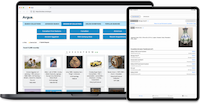What Does AI Mean to Museums?

Rachael Cristine Woody
The museum field is not one that considers itself “cutting edge” or even very technical, and yet AI can have a tremendous positive impact on our work and how we engage with our audiences.
Artificial Intelligence (AI) entered widespread public awareness with the arrival of ChatGPT on November 30, 2022. Developed by OpenAI and Microsoft, ChatGPT is described as a chatbot and virtual assistant, and is freely available to anyone with an internet connection. Its arrival caused “space race” energy with other leading tech companies rushing to launch their own AI. This also induced scrambling by many other companies to incorporate AI into their products to set themselves apart from their peers and avoid lagging in this technical evolution.
The Differences between AI and GenAI
To begin, it is important to understand the forms of AI currently available. There’s AI and Generative Artificial Intelligence (GenAI). What’s the difference between AI and GenAI? Let’s review how AI answered this question when using Google with the prompt “ai vs genai difference”:
According to this GenAI answer:
AI: Uses pre-defined riles, algorithms, and historical data to make predictions and decisions. For example, conversational AI, which is uses in chatbots and virtual assistants uses AI to understand users and generate human-like responses.
GenAI: Uses patterns it learns from existing data to create new content, such as images, text, and music. GenAI can mimic human creativity and has a wide range of applications, including artistic expression and problem-solving.
Both AI and GenAI learn from taking in information. Therefore, they are only as good as the information to which they have access. Additionally, AI and GenAI are experimental and still learning. Just as we are learning what it is, what is possible, and how to best wield it as one of our many tools. AI (in all flavors) will revolutionize how we work and live, but first, both humans and AI have a lot more experimenting to do.
AI and the Museum Field
AI and GenAI have been explored to some extent by the field. For example, GenAI was included in the Center for the Future of Museums TrendsWatch Report for 2024. The examples the report articulated for possibilities of AI-application included exhibition development, exhibit label writing, donor communications, report writing, and grant applications. These are of interest, and certainly have the potential to increase our job capacity, but ignore the possibilities for intuitive data creation work and the fantastical ability to bring art to life. Part of our challenge will be to learn enough about the technology to pursue application, and to gain access to knowledge experts and the technology needed for some of the more magic-like elements.
AI and the Near Future of Museums
For our purposes, I would like to emphasize that AI can be trained with datasets—and what are museums and archives if not full of collection information? We are a veritable GenAI playground of resources and the possibilities I see for us are pretty incredible.
Over the next few weeks, we’ll explore how AI can be deployed at the museum, from improving the visitor experience, to doing the heavy lifting on data creation, to elevating the museum role as an empathy generator via AI-animated art and interacting with AI-crafted historical figures.
Conclusion
As we move forward, our focus will be on the use of GenAI in museums with an exploration of enhancing museum audience experiences as well as helping to improve our collection description and discovery work. Next week we’ll evaluate how AI is increasing in-person accessibility, facilitating dynamic wayfinding, and remixing the storytelling elements of exhibitions.
Additional Reading

Rachael Cristine Woody
Energized by this post? Please join us for the companion webinar Museum Collections Online and the Potential of AI, September 25, 2024 at 11 a.m. Pacific, 2 p.m. Eastern. (Can’t make it? Register anyway and we will send you a link to the recording and slides afterwards). Register now or call 604-278-6717.
**Disclaimer: Any in-line promotional text does not imply Lucidea product endorsement by the author of this post.
Never miss another post. Subscribe today!
Similar Posts
Exploring No-Code Digital Storytelling: Hoover’s “Fanning the Flames” Exhibit
Explore no-code digital storytelling with Hoover’s ‘Fanning the Flames’ exhibit. See how interactive tools (Deep Zoom Color Compare & Hot Spot) enhance user engagement and the visual experience.
An Introduction to Scrollytelling for Museums
Discover how museums use scrollytelling and digital storytelling platforms to create immersive narratives. This introduction explores key concepts and approaches to interactive storytelling.
Exploring Self-Determinate Multiple Pathways: An Example of Digital Storytelling
Discover how self-determinate multiple pathways offer flexible interactive storytelling in museum exhibits. Learn from the Tenement Museum’s ‘Your Story Our Story.’
Digital Museum Storytelling Example: A Look at Self-Determinate Linear Pathways
Self-determinate characteristics on a linear pathway go beyond brief sidebar topics and instead offer alternative ways to navigate the linear pathway.







Leave a Comment
Comments are reviewed and must adhere to our comments policy.
0 Comments